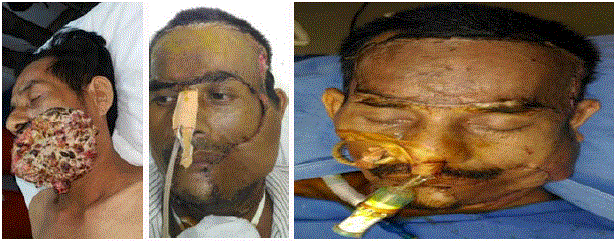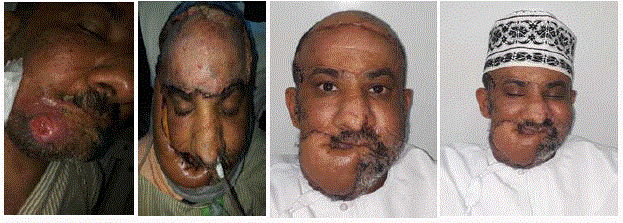Case Report
Lateral Forehead Flap: A Reliable Flap in Difficult Conditions
Agarwal Avinash, Sharma Manik and Nanda Vipul*
Department of Cosmetic and Plastic Surgery, Artemis Hospital, India
*Corresponding author: Nanda Vipul, Department of Cosmetic and Plastic Surgery, Artemis Hospital, Secotor 51, Gurgaon, 122001, India
Published: 02 Nov, 2017
Cite this article as: Avinash A, Manik S, Vipul N. Lateral
Forehead Flap: A Reliable Flap in
Difficult Conditions. Clin Surg. 2017; 2:
1713.
Abstract
Introduction: Complex orofacial defects pose a difficult problem for reconstructive surgeon. History
of previous surgery or radiation adds to the difficulty of reconstruction. In era of microsurgery, use
of locoregional flaps, alone or in combination may prove to be the only practical solution in certain
situations.
Patients and Methods: Two cases of oral carcinoma were resected and the defects were reconstructed
using the lateral forehead flap with the pectoralis myocutenous flap. In one of the cases 5th rib was
harvested with PMMC flap for reconstruction of the mandibular defect.
Result: In both the cases the donor defect was covered with split skin graft. All flaps survived and
functional outcome was satisfactory. Aesthetic outcome of the donor defect was also acceptable.
Conclusion: Lateral forehead flap is a reliable flap with an acceptable outcome in patients with
previous history of radiation and surgery.
Introduction
Complex orofacial defects have always posed a challenge for reconstructive surgeons. The aim of reconstruction in these cases is to achieve adequate, stable mucosal and skin coverage with minimal contour deformity. Sometimes these cases have been previously operated or irradiated which adds to the problems in decision making. Microsurgical tissue transfer is considered the first options in such cases, but these have inherent limitations such as paucity of donor vessels, long operative duration and intensive monitoring. In such cases regional flaps may present a reasonable option. The Pectoralis major myocutenous flap (PMMC flap), DP flap, Submental flap and forehead flap have been described for such reconstructions [1]. For a larger tissue requirement a double pedicled flap may be used [2]. If one flap is inadequate, a combination of flaps may be used. We present two such cases where we used the lateral forehead and PMMC flap for coverage of complex defects. As both the flaps are raised from opposite directions the final suture line of flap inset is not superimposing on each other which safeguards the possibility of orocutenous fistula in case there is dehiscence of one of the flaps.
Patients and Methods
Case 1
A 41-years old male presented with 12 cm × 10 cm large fungating mass involving the left lower
lip and adjacent for which wide excision with neck dissection and segmental mandibulectomy was
done. PMMC flap with rib and lateral forehead flap was used for reconstruction. PMMC flap with
rib was raised in standard fashion with skin paddle of 4 cm × 6 cm and 5 cm segment of the 5th rib.
Bony fixation was done with plate and screws.
Lateral forehead flap based on left STA was raised in standard fashion for skin cover. Lower
margin of flap was taken at the upper border of eyebrows. The junction of forehead and hair bearing
scalp was taken as upper limit of flap. The donor defect was covered with split skin graft (Figure 1).
Final detachment and insetting of flap was done after 4 weeks. At 6 weeks follow up he was
eating and swallowing soft diet without difficulty and was referred for further radiotherapy.
Case 2
47 years male was presented with ulcerative lesion over right side of chin for last 4-5 months.
He had history of Chemotherapy and surgery with radiotherapy 4 years ago. He was a known case
aortic valve replacement on medication. Wide local excision with segmental mandibulectomy was done. PMMC and lateral forehead flap was used for reconstruction.
PMMC flap was raised in standard fashion with skin paddle of 7
cm x 8 cm to fill the mucosal defect.
Lateral forehead based on right STA was raised for skin cover.
Forehead flap was delayed after 6 weeks of surgery and final
detachment and insetting was done in 7th week. He was eating and
swallowing comfortably (Figure 2)
Figure 1
Figure 1
The junction of forehead and hair bearing scalp was taken as upper limit of flap. The donor defect was covered with split skin graft.
Figure 2
Figure 2
Lateral forehead based on right STA was raised for skin cover. Forehead flap was delayed after 6 weeks of surgery and final detachment and insetting
was done in 7th week.
Discussion
Reconstruction of composite orofacial defect is a challenging
problem. This is especially true in recurrent or post radiotherapy
patients where have very limited options. In modern times free flaps
are considered to be the flap of choice with locoregional flaps as the
second option. But free flaps have their own limitations. Patient with
recurrent head and neck cancer have compromised general physical
status associated with co morbidities which makes long duration
surgery a risky option. In previously operated or irradiated head
and neck cases, the surgeon may encounter lack of vessels for micro
vascular anastomosis. Free flaps require vigorous post op monitoring
and occasionally may require re exploration. Above all, free flaps are
associated with four time’s greater risk of complications in case of
previous history of radiation [3].
Locoregional flaps provide a feasible option in these cases. The
operative time is much less and intensive post operative monitoring is
not required. These flaps are based on reliable vascular supply which
lowers the overall risk. The colour match is also better with these flaps.
In our cases we have used lateral forehead and PMMC flap to
cover the defect.
The lateral forehead flap is based on the anterior division of STA
and inclusion of zygomatic branch further improves vascularity of
the flap [4]. Several authors have described the use of lateral forehead
flap for oral mucosal lining as well as for skin cover. Flap detachment
and insetting is done after a gap of 3-4 weeks depending on the size of
flap, area of contact and condition of tissues [5,6].
In one of our cases second stage was delayed as the area of inset
was less and the flap involved previously irradiated and scarred.
A major disadvantage of forehead flap is the patch effect of the
skin graft over the forehead. To reduce the cosmetic impact we
harvested the whole of the forehead skin as single unit to camouflage
the scar. Further a 45 degree beveling was used on the edges of the flap
to avoid the abrupt contour change.
The relative inelasticity of flap is another feature of the forehead
flap which makes it difficult to contour. It does become supple with
time usually. It is a very sturdy flap which may be used to cover any
part of ipsilateral face [7].
In both of our cases PMMC flap was used for the mucosal lining.
This flap has been used for reconstruction of lower face for long. Many
variations of this flap have been described to reconstruct different
defects. PMMC with rib has been documented for complex defects
involving mandibular reconstruction. Usually 5th rib is harvested for
this purpose [8].
A dual flap combining lateral forehead and PMMC flap is a useful
approach in similar cases. Both of these flaps are robust which makes
the final outcome dependable. Also as the flaps are being harvested
from the opposite directions the flap inset and suture line are not
superimposing on each other. This provides a safeguard against development of orocutenous fistula in case one of the flaps suffers
breakdown of the suture line.
Conclusion
Reconstruction using the above mentioned technique is a useful, effective and a reliable method. In patients with recurrent oral cancer who have undergone prior surgery and radiotherapy this may be the only practical solution. We reiterate the usefulness of the lateral forehead flap.
References
- Farwell DG, Futran ND. Flap choice in head and neck reconstruction. Facial Plast Surg Clin N Am. 2003;11(1):107–19.
- Prakash BV, Mohammed Zuhaib, Hemanth Nagavarma. Versatility of Bi- Paddle PMMC Flap in Reconstruction of Oral Facial Defects. Int J Sci Res Manag. 2017.
- Lee S, Thiele C. Factors Associated With Free Flap Complications After Head and Neck Reconstruction and the Molecular Basis of Fibrotic Tissue Rearrangement in Preirradiated Soft Tissue. J Oral Maxillofac Surg. 2010;68(9):2169–78.
- Supit L, Sudjatmiko G. The Extended Lateral Forehead Flap: Today as was 50-years ago. J Plast Rekonstr. 2012;1(4).
- Agbara R, Fomete B, Obiadazie AC, Omeje KU, Amole OI. The forehead flap: a valuable option in resource depleted environment. Plast Aesthetic Res. 2016;3(4):115.
- Menick FJ. Nasal Reconstruction with a Forehead Flap. Clin Plast Surg. 2009;36(3):443–59.
- Ranjan K, Ashok D, Srimanta M, Sudhakar GVS, Ashutosh V. Utilization of the Forehead-Flap to Repair Skin Defect Following Maxillectomy: A Case Report. 2017.
- Shunyu NB, Medhi J, Laskar HA, Lyngdoh N, Syiemlieh J, Goyal A. 5th Rib Osteo-pectoralis Major Myocutaneous Flap—Still a Viable Option for Mandibular Defect Reconstruction. Indian J Otolaryngol Head Neck Surg. 2014;66(4):414–7.


